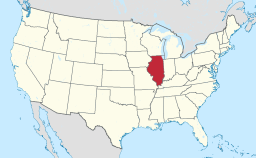Quincy, Illinois
| Quincy | ||
| City | ||
|
From left to right: The Bayview Bridge, Francis Hall on the Quincy University campus, Quincy Museum, Lincoln-Douglas debates mural in Washington Park, intersection of 8th and State in the South Side German Historic District, John Wood Mansion, neighborhood in the Northwest Historic District [top], the Oakley-Lindsay Center [bottom], the Gardner Museum of Architecture and Design.
|
||
|
||
| Official name: City of Quincy | ||
| Nickname: Gem City | ||
| Country | United States | |
|---|---|---|
| State | Illinois | |
| County | Adams | |
| Elevation | 568 ft (173.1 m) | |
| Coordinates | 39°55′56″N 91°23′19″W / 39.93222°N 91.38861°WCoordinates: 39°55′56″N 91°23′19″W / 39.93222°N 91.38861°W | |
| Area | 15.94 sq mi (41.28 km2) | |
| - land | 15.91 sq mi (41 km2) | |
| - water | 0.04 sq mi (0 km2), 0.25% | |
| Population | 40,798 (2012) | |
| - metro | 77,406 | |
| Density | 2,761.2/sq mi (1,066.1/km2) | |
| Government | Mayor-council | |
| Mayor | Kyle A. Moore | |
| Timezone | CST (UTC-6) | |
| - summer (DST) | CDT (UTC-5) | |
| ZIP codes | 62301, 62305, 62306 | |
| Area code | 217 | |
|
Location in Adams County and the state of Illinois.
|
||
|
Location of Illinois in the United States
|
||
|
Website: www |
||
Quincy (/ˈkwɪnsi/ KWIN-see), known as Illinois's "Gem City," is a city on the Mississippi River and the county seat of Adams County, Illinois, United States. The 2010 census counted a population of 40,633 in the city itself, up from 40,366 in 2000. As of July 1, 2015, the Quincy Micro Area had an estimated population of 77,220.
During the 19th Century, Quincy was a thriving transportation center as riverboats and rail service linked the city to many destinations west and along the river. It was once Illinois's second-largest city, surpassing Peoria in 1870. The city holds several historic districts, including the Downtown Quincy Historic District and the South Side German Historic District showcasing the architecture of Quincy's many German immigrants from the late-19th century.
Quincy's location along the Mississippi River has attracted settlers for centuries. The first known inhabitants to the region were of the Illiniwek tribe. Years later, following numerous incursions, the Sauk, Fox and Kickapoo also called the site home.
...
Wikipedia




